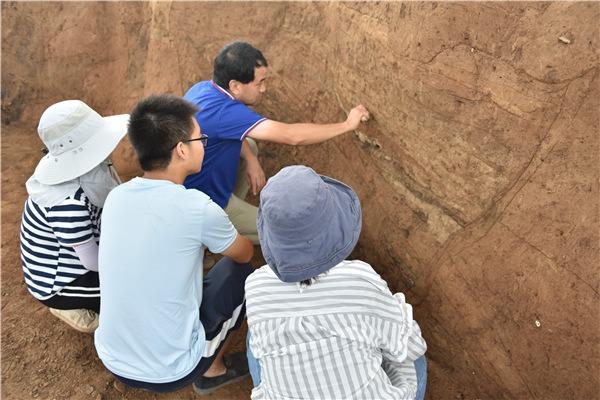 Zhao Haitao leads a team of archaeologists working on the ruins of Erlitou in July. The heritage site in Henan province is a pivotal reference to know how the earliest dynasty was formed in China. (PHOTO PROVIDED TO CHINA DAILY)
Zhao Haitao leads a team of archaeologists working on the ruins of Erlitou in July. The heritage site in Henan province is a pivotal reference to know how the earliest dynasty was formed in China. (PHOTO PROVIDED TO CHINA DAILY)
To Chinese archaeologists, the Xia Dynasty (c 21st century-16th century BC) once seemed both distant and close. As the first dynasty in China, which is recorded in Shiji (Records of the Grand Historian)-the foundational text of Chinese history, dating back to the first century BC-it is like an emotional complex for generations of scholars, who have long been eager to move its story beyond legend.
According to Shiji and Bamboo Annals, a collection of chronicles from the Warring States Period (475-221 BC), the Xia Dynasty existed for 471 years and had 17 kings over 14 generations
However, a rigid attitude toward research means the process is time and energy consuming.
According to Shiji and Bamboo Annals, a collection of chronicles from the Warring States Period (475-221 BC), the Xia Dynasty existed for 471 years and had 17 kings over 14 generations.
ALSO READ: Chinese archaeologists discover 2,000-year-old liquor in tomb
While written characters from the assumed period-the only way to prove the Xia's existence in some people's eyes-have never been unearthed, many scholars believe that the Erlitou site, the ruins of a state capital-like city covering 3 square kilometers in Luoyang, Henan province, offers the closest answers to the Xia's legacy beyond legend.
Archaeologists unveiled this year's new findings during a National Cultural Heritage Administration conference last week. These may not only prove a breakthrough for studies of the city's structure but also cast new light on people's understanding of China's urban-development history in general.
"The earliest known multigrid layout in ancient Chinese capital cities was discovered this year," says Zhao Haitao, an associate research fellow with the Institute of Archaeology that's affiliated with the Chinese Academy of Social Sciences.
He is also a leading archaeologist working at the Erlitou site.
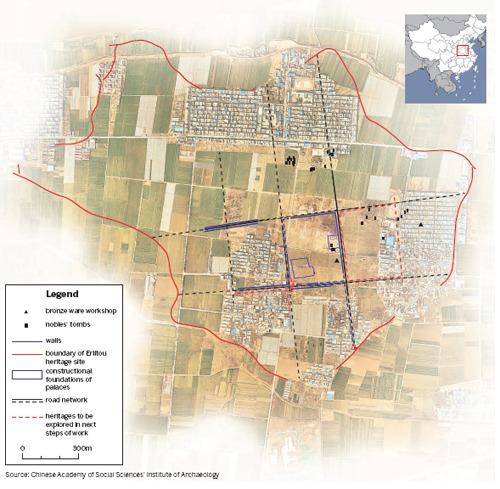 An illustrated map of Erlitou shows the city was divided into separate grids by crisscrossing road networks. (PHOTO PROVIDED TO CHINA DAILY)
An illustrated map of Erlitou shows the city was divided into separate grids by crisscrossing road networks. (PHOTO PROVIDED TO CHINA DAILY)
According to Zhao, the ruins of roughly 400-meter-long roads framed by walls were found to extend westward from the northern and southern sides of Erlitou's palace area. The road to the northern side is 14 meters wide, and the adjacent wall is 1.5 to 2 meters thick.
"This indicates the city was divided into separate grids by crisscrossing road networks," Zhao adds.
Early state
The Erlitou site has ignited fierce academic debate since it was discovered in 1959.
In recent years, a mainstream theory in China has led archaeologists to believe the site to be Zhenxun, the last recorded Xia capital city, mainly because of analyses of its unearthed objects, documents from later periods and comparative studies with other ruins near Erlitou. The most recent carbon dating shows this city existed from about 1750 BC to 1520 BC, which accords with ancient records.
However, the lasting dispute about which dynasty it belongs to seems to have distracted experts from digging deeper to uncover the city's significance.
Du Jinpeng, a researcher with the Institute of Archaeology who led the excavations in Erlitou in the 1990s, says the first 40 years of studies of the site only provided some scattered "puzzles" and lacked the clues needed for a major breakthrough.
"But the last 20 years of efforts focusing on the city's layout have helped us to gain a general understanding of its structure," Du says. "The new finding is exciting because the city was well planned and more advanced than Yinxu from a later period."
The centuries-younger Yinxu Ruins in Anyang, Henan province, are the remains of the Shang Dynasty's (c. 16th century-11th century BC) capital and home to oracle-bone inscriptions-the earliest written Chinese characters discovered.
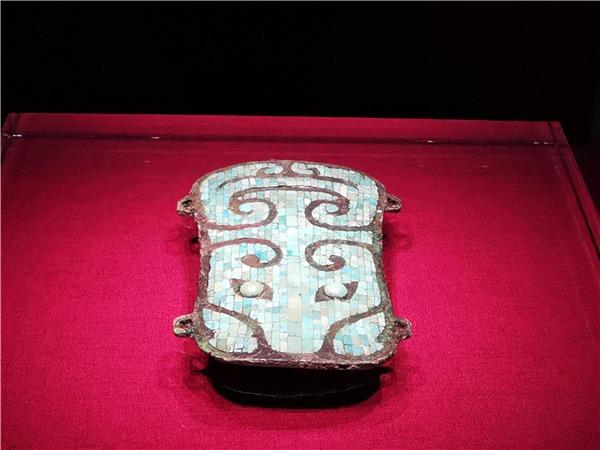 A turquoise-inlaid bronze plate unearthed in the Erlitou site. (WANG KAIHAO / CHINA DAILY)
A turquoise-inlaid bronze plate unearthed in the Erlitou site. (WANG KAIHAO / CHINA DAILY)
As to the multigrid layout in ancient Chinese capital cities, experts believe the most famous example may be the metropolis of Chang'an (today's Xi'an in Shaanxi province), which was the capital of the Tang Dynasty (618-907). Its layout is like a huge chessboard composed of walled-in residential communities and business districts. This format was also borrowed by ancient capital cities in Japan.
"The grids of Erlitou could be the origin of such layouts," says Lei Xingshan, dean of the School of Archaeology and Museology of Peking University.
"It shows the high-level governance and organization of its time. And this system was inherited by later dynasties and became part of our cultural genes."
Since many tombs and architectural structures have been unearthed on different levels at the Erlitou site in the past years, Zhao considers a multigrid model as helpful in explaining the city's planning.
"People in different social classes probably lived in separate walled-in areas and were buried in the same neighborhood after they died," Zhao says.
"This will provide key clues for our studies of ritual systems, urban planning and stratification of society of Erlitou.
"But this is only the beginning. We need more evidence to figure out the differences among various grids to gain a comprehensive understanding on their functions."
The past 20 years have witnessed a long list of key discoveries in Erlitou, like the remains of palaces, altars, nobles' tombs and ceremonial artifacts like a dragon-shaped decorative object made of more than 2,000 pieces of turquoise.
"All of these have shown that Erlitou was a political, economic and cultural hub, indicating kingship," Zhao says.
"And the new evidence of the city's layout further displays a highly developed civilization, matching the sophistication of the Xia Dynasty in history. The site is a pivotal reference to know how an early-stage state was formed in China."
However, only 45,000 square meters, or 1.5 percent of the total area, of the Erlitou site have been excavated so far.
For Zhao's team, much remains unknown. For example, the city's outer wall and the royal family's graves were not found in Erlitou. Erosion from the nearby Luohe River may have also permanently erased key clues.
"Whether they exist or not, people deserve to know," Zhao says.
"And if Erlitou was the capital, how did it control a country with a vast territory? So much research needs to be done."
Song Xinchao, deputy director of the National Cultural Heritage Administration, says: "If we only look at Erlitou, we cannot really understand its features. It has to be compared with other sites from its time to draw a bigger picture."
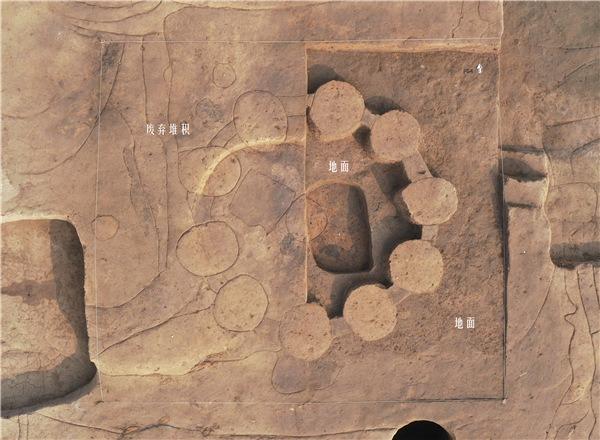 Round earthen piles unearthed in the Shizhuang site in Henan province's Zhoukou are believed to be constructional foundations of barns dating back 3,700 to 4,000 years ago. (PHOTO PROVIDED TO CHINA DAILY)
Round earthen piles unearthed in the Shizhuang site in Henan province's Zhoukou are believed to be constructional foundations of barns dating back 3,700 to 4,000 years ago. (PHOTO PROVIDED TO CHINA DAILY)
In August, the cultural heritage administration announced that a five-year national research program exploring Xia culture had been launched. It involves not only Erlitou but also other sites in such provinces as Henan, Hebei, Anhui, Shandong and Shanxi.
Fruitful discoveries have burgeoned this year.
For example, legends surrounding Yu the Great, the ruler who founded the Xia Dynasty according to historical records, may not only be stories handed down through word of mouth.
In Shiji, the ruler is recorded to have met other tribal leaders in Tushan. He married a local woman and thus formed a powerful alliance. Although a village in Bengbu, Anhui province, was speculated to have been the location of their meeting, and the name of the village, Yuhui ("meeting of Yu"), also lent credibility to the story, the account had for long seemed scantly supported by strong evidence.
However, the 180,000-square-meter city ruins in the village that date back 4,100 to 4,400 years, which were excavated this year, may create more room for imagination.
Zhang Dong, the program's leading archaeologist, unveiled the discovery of a 300-meter-long section of the northern wall and a 600-meter-long stretch of the eastern wall.
Rich discoveries of human settlements and possible remains of drainage systems were found, making it the largest city ruins from that time to be found along the middle reaches of the Huaihe River.
"Although the dating of the site does not perfectly match with Xia chronologies, we found it was a booming settlement during its time," Zhang says.
"The discovery shows that Yu's meeting may have actually happened, but things can only become clearer through our subsequent work."
More sites
Yet other archaeological findings do not exist in historical records at all.
At the Shizhuang site in Zhoukou, Henan province, a group of 28 ruined structures are thought to be barns following the discovery of carbonized millet in the earth. Carbon dating shows they are from 3,700 to 4,000 years ago, which is within the Xia period.
According to Cao Yanpeng, the leading archaeologist on the site, the round earthen piles were constructional foundations of barns elevated on stilts, while other samples in China from even earlier periods were usually cellars.
And surrounding remains show the site used to be a fortified city that possibly functioned to ensure national food security.
"It's crucial to our studies of early-stage states' government structures and tax systems," Cao says.
READ MORE: Remains of small ape, now extinct, found in ancient tomb
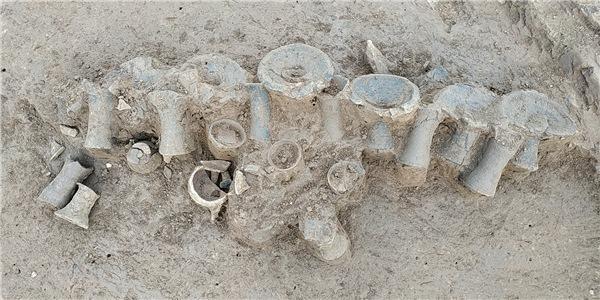 Ruins of the Yuzhuang site in Henan's Pingdingshan show a complicated ritual system in the late Neolithic period. (PHOTO PROVIDED TO CHINA DAILY)
Ruins of the Yuzhuang site in Henan's Pingdingshan show a complicated ritual system in the late Neolithic period. (PHOTO PROVIDED TO CHINA DAILY)
Also in Henan province, tombs indicating complicated ritual systems at the Yuzhuang site in Pingdingshan and the remains of jade craftsman's settlements at the Huangshan site in Nanyang portray a picture of different cultures communicating with each other and societies growing more complex.
Both sites date back to the late Neolithic period, on the eve of Erlitou's rise as a cultural core, which was also the twilight of civilization in Central China.
"I have to say, the new findings do not answer old questions," Song says.
"They raise more questions. But that's how our understanding of the Xia becomes enriched from different perspectives."


